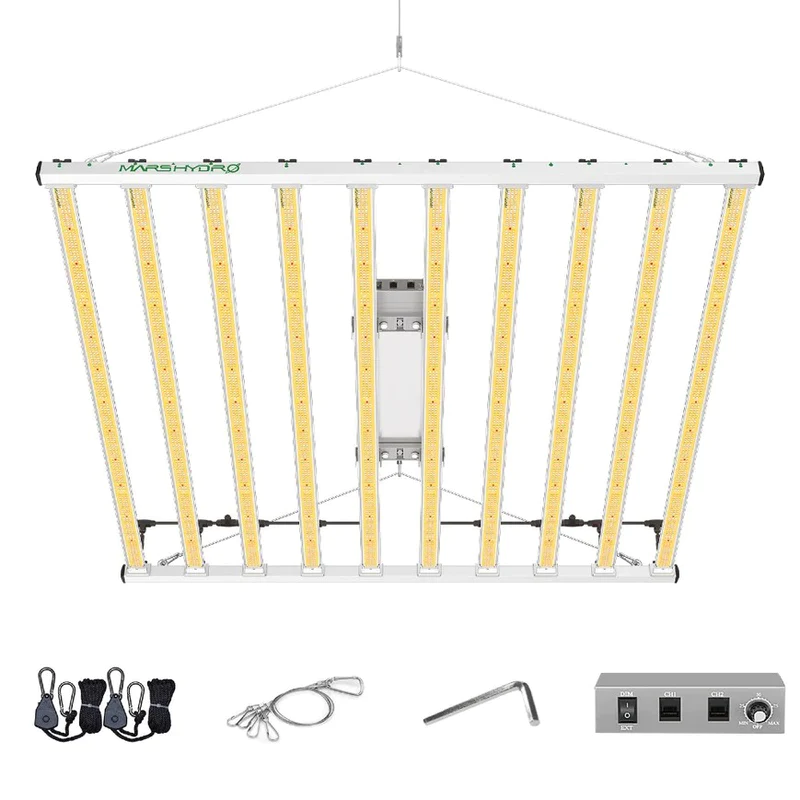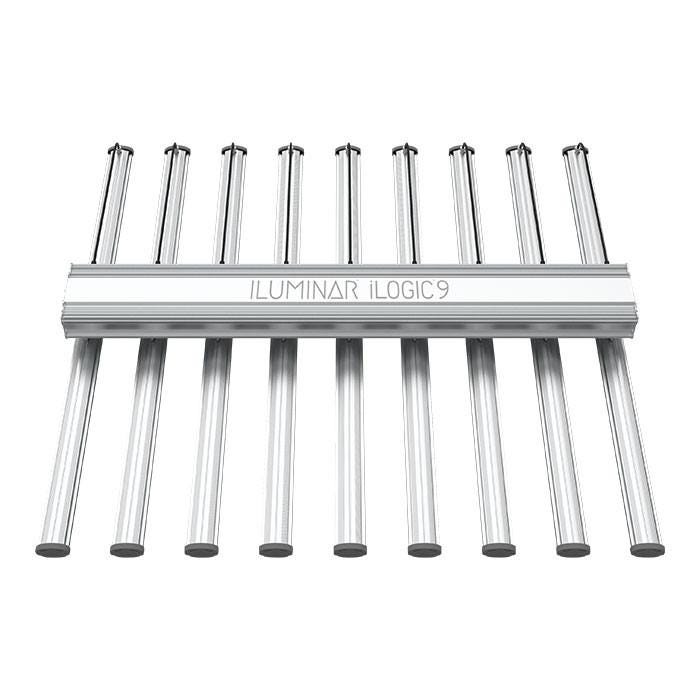Mars Hydro FC-E1000 Bridgelux 1000W LED Grow Light VS Iluminar 1000W iLogic™9 Full Spectrum LED Grow Light
Lighting is critical as they significantly affect a plant’s growth cycle, photosynthesis, and thus plant health, flowering and fruiting. Light is crucial to plant growth. LED grow lights are replacing metal halides due to their efficiency and cost-effectiveness.
How many lights should I have?
How many grow lights you need is entirely dependent upon the number of plants that you have. You’re going to have to take a few things into consideration when you’re determining how many lights you’ll need. You need to know your:
Plant Coverage: How much light each plant will receive from a light
Light Intensity: The amount of light needed for optimal growth, measured in Lumens for HID lights, and PAR for LED grow lights
Follow the steps below to calculate exactly how many lights you’ll need for your plants.
Research Your Plants Lumen or PAR Needs: Some plants need more Lumens or a higher PAR value to grow well, while others need less. While you could always guess, this won’t necessarily be the best thing for your plants. For example, leafy greens like PAR value at about 200, while flowering and fruiting plans prefer a PAR value anywhere from 400 to 500. You can easily measure PAR with a PAR meter to be absolutely sure what your plants are receiving.
Measure Your Required Plant Coverage: Think about the size of your plants, both in terms of current size and expected size. Measure the ideal space fully grown plants will need, and how tall they’ll be. Then, determine the amount of square footage you’ll need to grow your plants indoors.
Choose a Grow Light Based on Intensity and Coverage: Grow lights provide measurements of their light intensity, as well as the square footage they can cover from a certain height. Generally speaking, 32–50 watts of artificial light per square foot is a good starting place.
Mars Hydro FC-E1000 Bridgelux 1000W LED Grow Light

Features:
The Mars Hydro LED Grow Light has a full spectrum for full cycle plant growth. FC-E1000W is specially designed for high PPFD culture (such as high concentration CO2 growth). It is by far the most powerful grow light with a high PPF of 2,766 umol/s and an average PPFD of over 1,300 umol/m2/s. The FC-E1000W is slightly different from other FC-E LEDs because of its scalable flexibility, allowing for customization and configuration. Typically, 10 light bars are arranged on 2 support bars to provide an unusually high amount of power for an area of 4x4 feet.
Iluminar 1000W iLogic™9 Full Spectrum LED Grow Light

Features:
The Iluminar Grow Light is the go-to high-efficiency lighting fixture for sealed grow rooms enhanced with CO2 supplementation. Nine light bars deliver extremely high light intensity and uniformity across a 4’ x 4’ footprint to drive unbeatable growth rates and flower production. Delivering an incredible 2800 μmol/s PPF, the iLogic™9 Full Spectrum fixture has the power to penetrate more deeply into the densest indoor plantations, giving lower growth tips the intensity they need to reach the canopy, resulting in more viable flower sites per plant. Cultivators enjoy bigger yields, higher quality, and more overall crop homogeneity. The enhanced canopy penetration frees growers from the chore of remedial foliage stripping in order to promote the development of lower and mid-tier flower sites.
How To Use Grow Lights
Growing indoor plants is a fun hobby that may soon become a thriving business. If it is your first time using these light fixtures to cultivate herbs, you must pass through a trial and error period. Do not be discouraged because everyone has gone through the same phase. Therefore, take your time to experience, learn, experiment, and have fun.
Here are recommendations on how to use grow lights properly:
Choose Lamps Wisely
Don’t just buy lamps without figuring out what to do with them in the first place. Keep in mind that better-quality lamps are more expensive for a reason. You only need to use them for a fraction of the time compared to cheaper alternatives. If you are going to grow seedlings for transplant, get bright lights. However, most houseplants only require low light. Hence, you can buy cheaper grow lamps and put the plants near the window to provide adequate natural light.
Put the Lights at a Good Distance
It is best to place the lights as close to the plants as possible. The distance varies depending on the lamp, but as a rule of thumb, place it around six inches from the plants. The plants will benefit from the light better when placed close enough. If the lamp is further away, the intensity of the light will decrease. If you use a bank of lights, adjust them as the plants grow.
Use a Timer
Some plants thrive better when provided with consistent lighting. Remember that many plants are day-length sensitive. Hence, they only need 8 to 10 hours of light per 24 hours. Giving them inconsistent hours of lighting can confuse them.
Determine How Much Light the Plants Need
Foliage plants require somewhere around 14 to 16 hours of light each day. Flowering plants require at least 12 to 16 hours of light per 24 hours. Some plants require approximately 18–24 hours of light during their vegetative state but need only 12 hours of light during the flowering stage. It is essential to give the plants total darkness during the remaining hours. Always turn the lights on and off consistently for the best results. Invest in an automatic timer for ease of use.
As much as possible, try mimicking the day length where the plants originated. It may not be essential, but it can be for some plants, like basil. Plants from temperate zones usually perceive the month based on how much light they get during the day. Hence, they may start or stop flowering depending on how many hours of light they get. Plants originating from the equator may not respond the same way because they are used to consistent 12 hours of lighting.
Be Sure to Water
Aside from light, plants need a sufficient amount of water for hydration. Most indoor plants need to be watered at least once every one to three weeks. You should monitor your plants and water them when necessary. The frequency will depend on the type of plant you have, its size, rate of growth, etc. For seedlings, make sure that they get evenly moist. Do your research on how much water your plants need, and provide enough hydration.
Maintenance
Always keep your grow lights clean and well-maintained. Remember that indoor gardens are a mix of water and electricity. Hence, it would be best to be careful when cleaning and maintaining indoor light fixtures.
Conclusion
Care-intensive tasks like harvesting plants indoors can indeed become a very difficult task without the proper awareness and expertise. A lot can go wrong if you don’t follow the correct steps, so we hope today’s guide will help you with all of your plant harvesting needs.
评论
发表评论